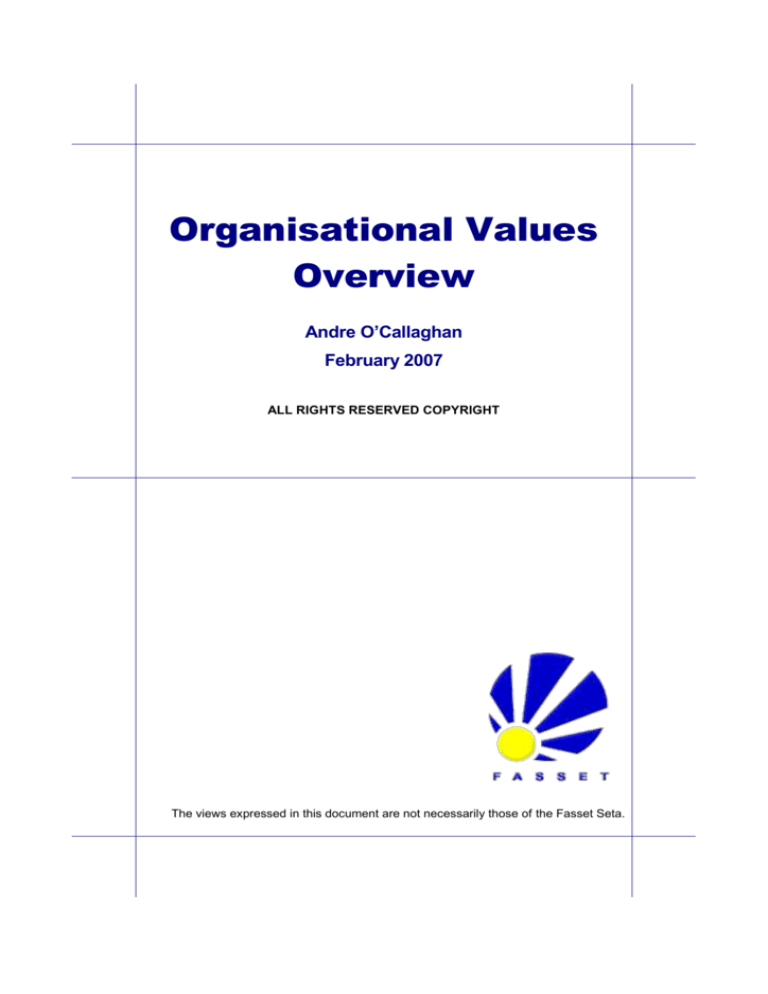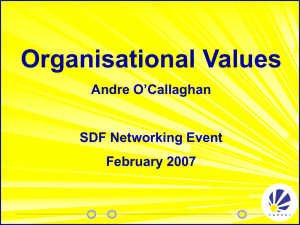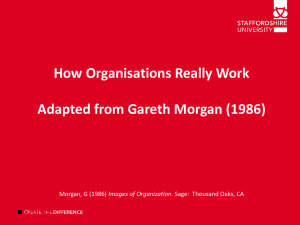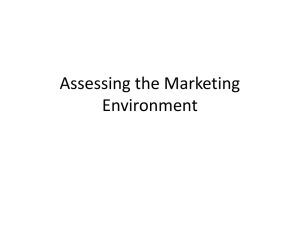
Organisational Values
Overview
Andre O’Callaghan
February 2007
ALL RIGHTS RESERVED COPYRIGHT
The views expressed in this document are not necessarily those of the Fasset Seta.
1. INTRODUCTION
Everything that can be counted does not necessarily count; everything that
counts cannot necessarily be counted
Albert Einstein
Why Values, What Values?
Our people are our most important asset
We value our customers
We stand for integrity
You’ve probably heard these words before – and most of us react with
skepticism when we hear them. Why is that? A large number of organizations
do not act and behave as if they really believe these words? These words are
the clear expression of a value, and organizations often make the mistake of
saying them, instead of doing them. Values should be visible through the
actions people take, not their talk.
The world of management is changing rapidly – according to Dolan et al
(2006) corporate leadership is being held accountable for higher performance,
society expects increased professional responsibility, quality and customer
service. We live and deliver in a post-Enron working environment, in the wake
of corporate scandals, wars and natural disasters – and in this new
dispensation, we are measured by that which is core to our humanness – our
values. Leaders in modern business need to balance what is good for
business, people and the society. A challenge indeed!
According to Dolan et al (2006) Management by Values (MBV) is fast
becoming the key ingredient to have a sustainable business. To manage by
values is crucial to guide employees and their behaviour; to gain commitment
and to ensure focus.
And yet, the corporate world often neglect values, or have a number of
misconceptions regarding core organizational values. For example (Collins,
1996):
You cannot ‘set’ organizational values, you can only discover them.
Nor can you ‘install’ new core values into people.
Core values are not something people ‘buy in’ to.
The word value is derived from the Greek word axios, meaning that which is
valuable and worthy of being honoured. It also refers to the Greek word axis,
meaning the point around which the essentials rotate or turn.
Values Overview – February 2007
1
Professor Milton Rockwach’s definition of values in 1973 is still regarded as
the ‘definitive. He described a value as ‘an enduring belief that a specific
mode of conduct or end-state of existence is personally or socially preferable’.
A value-system is therefore ‘an enduring organization of values and beliefs
concerning preferred modes of conduct or existence’.
2. MOVING FROM BELIEFS TO BEHAVIOUR (VIA
VALUES)
Values are the choices we make regarding what is required to achieve goals.
These choices are in turn derived from our beliefs. We often perceive these
beliefs as the ‘truth’. Values and beliefs form that foundation for norms – the
rules we live by. Norms are accepted or rejected according to our values.
Ultimately this manifests as attitudes and related behaviours.
OUTCOMES
Behaviour
Attitudes
Experience
Norms
Values
BELIEFS
Values Overview – February 2007
2
3. THE LINK BETWEEN VALUES AND STRATEGY
(THE ALIGNMENT CHALLENGE)
In client organisations where I consult on strategic planning, I often find that
the executives spend an inordinate amount of time on definitions for the
vision, mission and values. Once the words are ‘just right’, the plan is
accepted, signed of and filed. A recent survey showed that between 93-97%
of the Fortune 500 corporates have a vision, mission and values statement,
but only between 3-7% of employees know of it and work by it.
People implement strategy. They implement it through actions and effort,
which is underpinned by their own personal values. It therefore stands to
reason that the following need to happen:
Organisational values and personal values need to be closely aligned
(the more our personal values overlap with that of the organization, the
more committed we will be).
The organizational values need to support the key strategic goals and
vision of the company. Values are the key to the success of an
organization.
Think of some of the great success stories in the corporate world – 3M,
Johnson & Johnson, Virgin, MicroSoft, etc – at start-up there probably was no
formally defined vision. But the owner(s) had a set of strong personal core
values and a relentless drive for progress and a remarkable ability to translate
these into business results and growth.
The following fundamental ‘truths’ about values in organizations are crucial to
the successful alignment between business issues, personal values and
sustainability:
Values Overview – February 2007
3
Personal values will always override organizational values
All behaviour is values and belief-based
Aligned personal values and organizational values are key to optimal
performance
Values fall into three broad categories, i.e.:
Control values (values that relate to concepts/ideas and perceptions
about control).
Ethical values (values that we believe should be adhered to when we
deal with other people)
Development values (values relating to ideas/perceptions about
discovering, developing and creating something new).
For example:
Control Values:
Efficiency, planning, productivity,
responsibility, authority,
accountability, etc
Impacts on:
Ethical Values:
Sharing, listening, respect, trust,
openness, honesty, humour, etc
Decision making
Long term
objectives
Short term
objectives
Development Values:
Growth, research, creativity, etc
The link between Strategy and Values:
Vision Statements
Both people and organizations need to have a strong and clear idea of their
purpose, goals and values to be successful. This implies the following
(Heathfield, S.M):
Values Overview – February 2007
4
a vision for your desired future,
a mission that defines what your purpose is,
values that shape your actions,
strategies that will get you there, and
goals and action plans to guide you.
Your organization's success and your personal success depend on how well
you define and live by each of these important concepts. Research showed
that:
Companies whose employees understand the mission and goals enjoy a
29 percent greater return than other firms (Watson Wyatt Work Study).
A vision is a combination of three basic elements:
An organization's fundamental reason for existence – their ‘dream’ and
aspiration base (often called its mission or purpose),
The organisation’s timeless and unchanging core values, and
The key objectives
Of these, the most important to inspiring and sustainable organizations are its
core values.
It is important to understand that to merely have a vision is not the same as
being a truly visionary organization. The difference lies in creating alignment alignment with the core values, to that will:
Reinforce its purpose, and
Enhance and enable progress towards its aspirations.
When you have alignment, any visitor could drop into your organization from
anywhere and infer the vision and what you stand for without having to read it
on paper.
It is important to identify misalignments and create new alignments. An
effective technique is to facilitate focus groups and ask employees to identify
at least one thing in their work that is inconsistent with a core value. Some
examples:
Company A states that it values respect, freedom and innovation. Yet they
have a complex policy and procedure for approvals and customer interaction.
It is clearly a misalignment and needs to change.
Company B states that they value development and innovation. Yet they do
not have relevant procedures, mechanisms and tools that enable and
empowers staff to innovate and develop (i.e. no suggestion scheme, no or
little reward for innovation, etc).
Values Overview – February 2007
5
4. DEFINING AND ASSESSING ORGANISATIONAL
VALUES
All organizations have an underlying set of common values – no matter how
diverse the company is. Even global conglomerates are able to identify and
define a set of common values that is shared and drive behaviour.
How to identify values – that is often the key question executives and OD
specialists battle with. The key is to start at individual level and then to
proceed to the organizational level. There are many techniques and
methodologies that can be used:
AVI’s (A Value Inventory)
Questionnaires
Focus Groups
Appreciative Enquiry
Culture Surveys and assessments
Analysis of critical incidents, policies and procedures
The leadership should also consider key questions such as:
What core values do we bring to work – those values that are seen and felt
by employees
Would you want the organization to have these values
Are they enablers or obstructions
Do our customers share these values
5. BENEFITS OF A ‘VALUE-BASED’ ORGANISATION
(AND THE COST OF NOT ADDRESSING VALUES)
Why all the fuss about values and bringing values into the organisation? It is
quite fundamental – it drives and directs behaviour. In organisations where the
core values are clearly defined and support the strategy and business
objectives, the following benefits can be observed:
Policies, procedures and practices are coherent, supportive of strategy
and reflect the key values. This creates a sense of credibility and staff are
committed to them.
Recruitment and selection processes are based on values. The
appointment of talent is much more that a mere fit between the job and the
competencies of the individual. Appointments are also made based on the
fit between organisational and individual values. This results in better
retention, stronger cultural sense and better team work.
Values Overview – February 2007
6
Training and development is not only focusing on job competence –
innovative training takes place to enhance, embed and strengthen the core
values.
The values of the organisation and its employees are aligned with those of
its stakeholders – notable the customers and shareholders and its
communities. This creates sustainability, growth and profitability.
Employees feel responsible and accountable for meeting expectations – in
short a performing organisation.
It has been found that people can realise their potential more effectively
when their work is meaningful and when their personal values and needs
are integrated with the objectives of the organisation (Dolan, et al, 2006)
If people are behave according to and live out their personal core values
they are perceived as authentic and trustworthy.
If structures are aligned with core values, the organisation is perceived as
one with integrity
According to Smit & Cronje (2002) value alignment influences attitudes
and can have a major impact on organisational factors such as
productivity, staff turnover and absenteeism.
Clearly defined values form the basis of norms, ‘the rules of the game’.
This in turn influences the formation of standards, objectives and work
conduct.
Recognition of shared values gives employees and the organisation a
‘shared language’, which creates tremendous energy and intensifies
commitment, enthusiasm and drive. People start to care for their work and
stress is reduced.
6. HOW TO CHANGE VALUES (THE LEADERSHIP
CHALLENGE)
Leadership is the key to any cultural and values-based change. According to
Barret (2006):
1.
2.
3.
Leadership drives employee fulfilment
Employee fulfilment drives customer satisfaction
Customer satisfaction drives shareholder value and sustainability
In order to change values, it is important to understand how values are
created and established in organisations (Dolan et al, 2006):
The values and beliefs of the founder
The beliefs and values of the management team
The values and beliefs of the staff
Current legislation
The ‘rules’ of the market/industry
Prevailing social values
The history of the company
Values of stakeholders
Values Overview – February 2007
7
Because values are deeply entrenched and based on our beliefs and basic
assumptions, it is a complex and difficult process to change them. But it is
possible – and it starts with the leadership.
The key steps in repositioning or redefining the values and to ensure
sustainability are:
Create dissatisfaction with the status quo – establish a compelling
reason for change
Distil the essential values (reformulates values with maximum
participation at all levels)
Redefine vision, mission and key focus areas and communicate
Review practices, policies and procedures to ensure alignment with
new values
Monitor values through audits
Reinforce values through appropriate rewards and recognition
7. CULTURE, DIVERSITY AND VALUES
Maryland University defines diversity as (sic) ‘the otherness’, or those human
qualities that are different from our own and outside the groups to which we
belong, yet are present in other individuals and groups (Clements & Jones,
2006).
In a recent research paper by the United Nations in 2000, the UN
acknowledges diversity across many aspects of human existence, including
values, professional experience, skills, culture and social class. This is in
addition to the more traditional and obvious attributes of diversity, i.e. age,
race, gender, physical ability, sexual orientation, religion and language.
From the above, it is clear that human diversity is closely linked to the realm of
values – human value systems are diverse and impacts on the workplace.
According to (Kouzez & Posner, 2003) credible leaders honour diversity of
their many constituencies, but at the same time finds and stress common
values. They do not try to get everyone to be in accord with everything, but
create a common core of understanding.
If we do not share a common set of fundamental values, the result is often:
Intense conflict
False expectations
Diminished capacity, and
Poor performance on key stakeholder expectations
It also stands to reason that, in order to focus on, and manage diversity, it
should be embedded in a core value of the organisation.
Values Overview – February 2007
8
8. MAINTAINING VALUES – A CASE FOR 360º
REVIEWS
It is fairly easy to come up with value statements like ‘we value customer
service’, or ‘we value creativity’, etc. It is however a totally different issue to
ensure that it is lived, walked and talked in the organisation. Many
organisations battle to operationalise values and as such it often remain a few
words on a wall behind the CEO’s desk or in a boardroom.
One way of enhancing, reinforcing and rewarding values in an organisation is
with multi-peer reviews. A major financial institution in South Africa realised
this and embarked on a comprehensive intervention to firstly clarify their core
values, then to define the behavioural aspects that can be observed and
measured for each value. The definitions were communicated to all staff and
captured on an electronic assessment tool. Every quarter all employees, from
CEO level to the lowest level. Each staff member had to have at least 5
people who rated them on each value-set. The staff member also rated
him/herself. The raters have to be representative of:
A supervisor
Colleagues
Subordinates (where applicable)
Internal customers
Comprehensive feedback is given based on the feedback on a quarterly
basis, and strengths and weaknesses are identified.
After implementation, the organisation experienced a huge improvement on
brand awareness, customer focus, internal communication and credibility of
leadership. All employees started to talk the ‘language’ of their corporate
values and displayed an increased level of commitment to these values.
What is important to consider in implementing multi-rater reviews are the
following:
Training is crucial
Employees must be allowed to express concerns (i.e. subjectivity, bias,
victimisation, etc)
Trust needs to be strong in the organisation
All levels must be part of the process
Values Overview – February 2007
9
9. VALUES IN SMME’s (CHALLENGES AND KEY
LESSONS)
We find that values in SMME’s are mostly defined by the personal values of
the owner. Although little research exists regarding culture, values and beliefs
in SMME’s, evidence suggests the following:
Differences in values (owner and workers) are much more visible and
have more negative impact than in bigger organisations.
The leadership style in SMME’s is sometimes autocratic, based in the
belief that directive management is best to get things done.
Relationships are often closer and more personal than in bigger
organisations.
Trust, commitment and loyalty are often expressed values within
SMME’s by the owner. They value employees who think and act as
they do and this is often rewarded. Employees in SMME’s often
express core working values such as respect, creativity and care. We
often find major underlying conflict in SMME’s – often not overt.
Dissatisfaction is not expressed as the balance of power is not equal
and political games often surface as a result of this.
The challenge for SMME’s is to identify the core common values within the
ranks and actively promote them, whilst respecting diversity. Owners need to
accept that staff is not as emotionally attached to the business and that they
bring their own worldviews into the workplace.
10. CONCLUSION
Although intangible, emotional and under the surface, values impact on every
aspect of modern organisations. It guides behaviour, dictates how we interact
and treat our customers and ultimately determines whether we are happy at
work.
Value-based research clearly show that a strong aligned value base foster
commitment, performance and focus.
Any strategist will tell you that strategy and purpose become meaningless if it
is not embedded in values that are meaningful and relevant to the
organisation.
Values Overview – February 2007
10
11. SOURCES
Barret, R. Building a Values-Driven Organisation. 2006. ButterworthHeinemann
Clements, P, Jones, J. The Diversity Training Handbook. 2006.
Cambrian Printers, Wales
Dolan, S.L., et al. Managing by Values. 2006. Palgrave Macmillan, New
York
Kouzes, J.M, Posner, B.Z. The Leadership Challenge, 2002. JoseyBass Printing, San Francisco
Nel, P.S., et al. Human Resources Management. 2004. Oxford
University Press South Africa
Smit, P.J, Cronje, GJ de J. Management Principles. 2002. Juta & Co,
Ltd
Values Overview – February 2007
11









